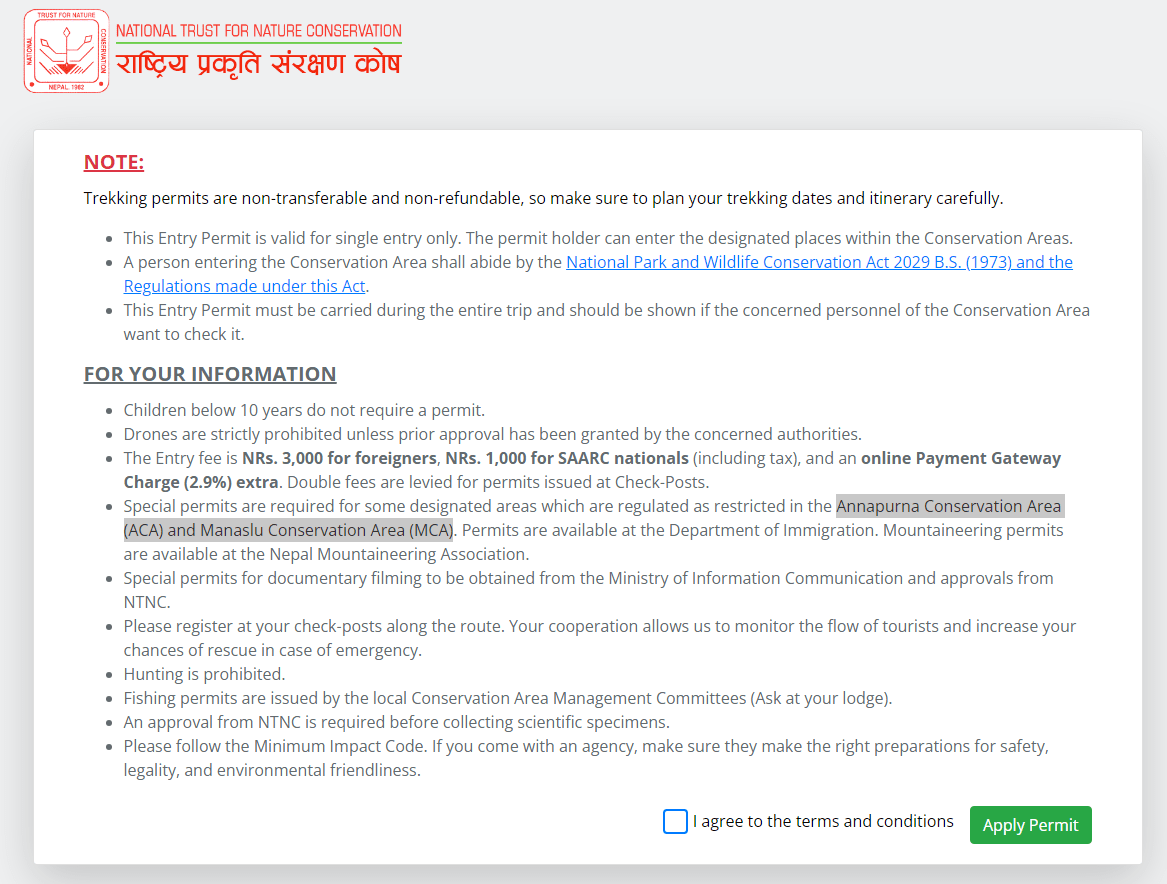
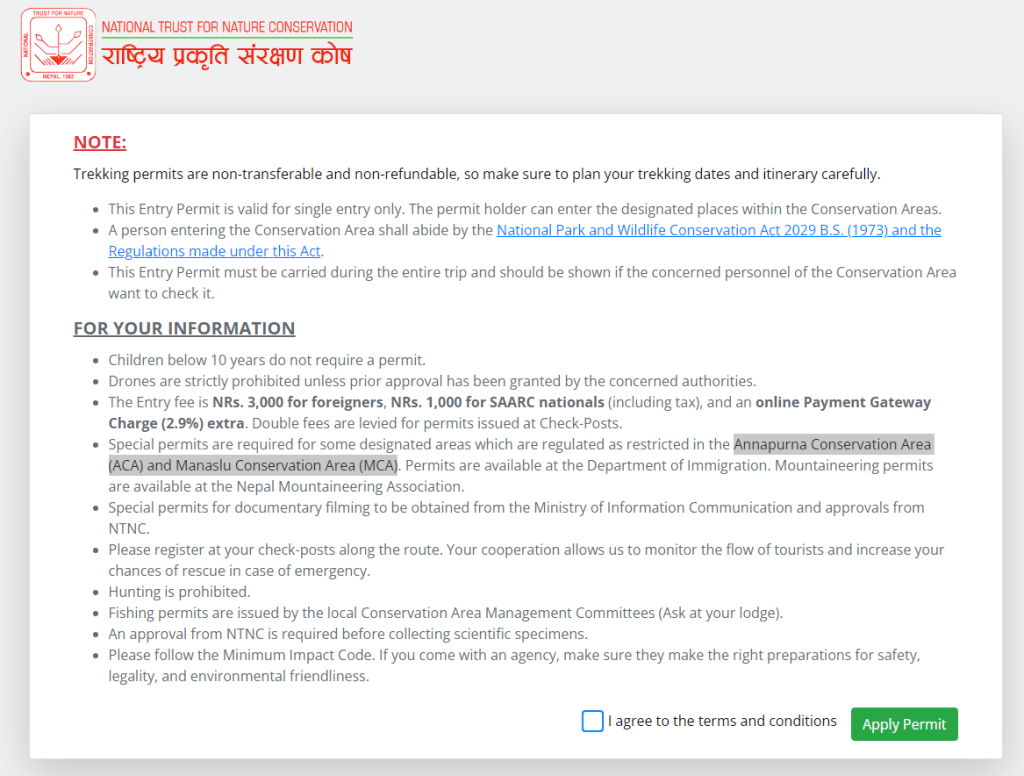
A new e-permit system has come online in Nepal, but there’s a catch
In 2024 The National Trust for Nature Conservation (NTNC) who run the Annapurna Conservation Area Project (ACAP) launched an online portal for trekking companies and trekkers to buy ACAP and MCAP permits online. Only the portal never worked very well and kept crashing.
In 2025 they’ve revamped things a bit and now issue e-permits for the Annapurna Conservation Area Permit (ACAP) , Annapurna Conservation Area Permit (MCAP), or Gaurishankar Conservation Area Permit (GCAP). I’ve tried it out, as have a few others, and it does seem to function a lot better. This essentially means, you can get your ACAP, MCAP, or GCAP permits yourself, before arriving in Nepal or when in Nepal.Previously you would have to visit an NTNC office, a permit office, have a trekking guide, or a National park entrance to get a paper permit. The latter would been paying double. While the tried and trusted office/guide system was fairly straight forward. And, you can still have your trekking guide get the permits if you want. The new system was not set up to make like easier for trekkers, it was set up to maximize profits. Less paper printing, less offices, less staff. All trekking agents are being told they most apply online for clients permits from now on. And here come the catches!
The new e-permit has several problems
1: As a trekker the first problem may seem like a minor one. It will now cost you more. There’s an extra “online payment gateway charge per permit of 2.8% to non-Nepali. That number has changed a bit since it’s introduction. And, despite being a “small” extra charge, it’s caused all types of additional problems. The first of which is, well, it’s discriminatory. Second, you’re being forced to pay extra. There is no alternative. The third problem is that some dubious trekking agents are charging even more than that and telling clients that they too are being charged extra. Fact: Trekking agents have a separate login, and are NOT charged extra.
2: The next problem revolves around the “Mandatory Trekking Guide” rule that Nepal Tourism Board (NTB) and Trekkers Agents Association of Nepal (TAAN) re-introduced in 2023. Something they’ve yet to actually set up any checkpoints for. Now, in 2025 NTNC have basically make it possible for independent trekkers to completely circumvent the mandatory guide rule, get there own permit, avoid a Trekker Information Management System (TIMS) charge, and head out trekking in the Annapurna Region themselves. You won’t here me complaining about that. The TIMS System is completely broken. However, I do believe first time trekkers should take a guide for some treks for the sake of safety. MissingTrekker.com highlights several treks where solo trekkers have had serious problems with in the past. That said, it’s one more step towards the return of independent trekking in Nepal. And, for many people it looks like NTNC is sticking it to NTB and TAAN and simply ignoring them. Who can blame them!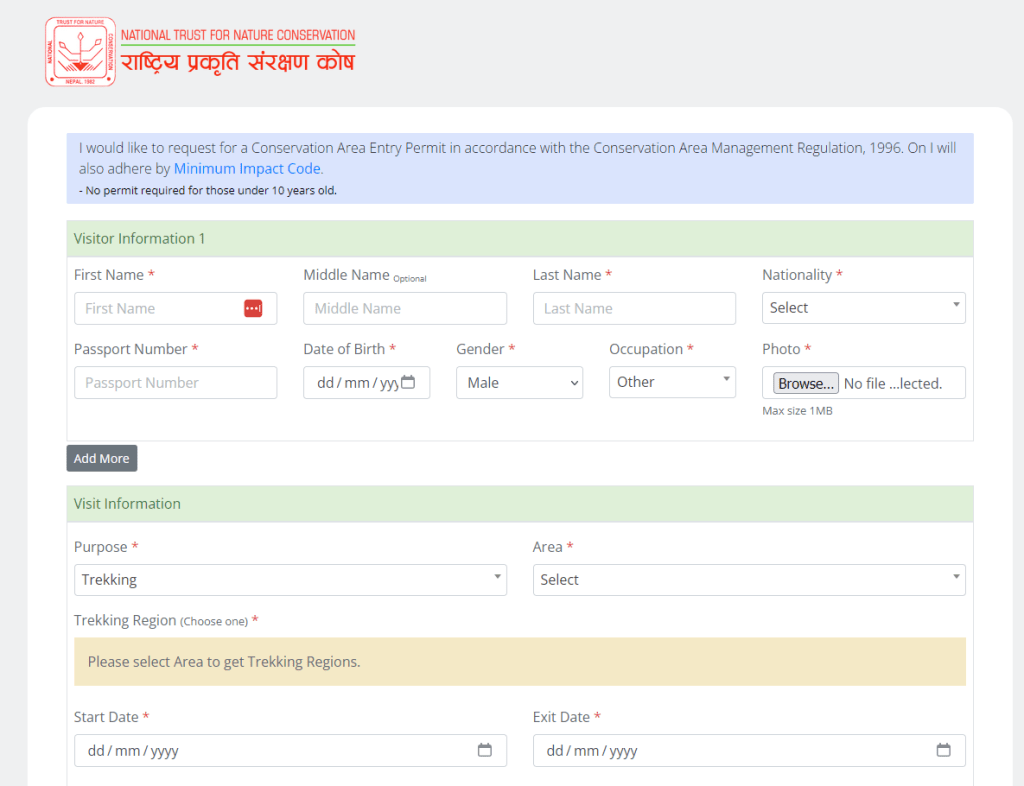 3: Next up on the problem list is the Manaslu MCAP permit. Considering most trekkers will want the permit to trek Manaslu, getting it themselves is pointless as they’ll also need a Manaslu Restricted Area Permit which can only be obtained by a licensed trekking agency with at least two non-Nepali trekkers applying, and a compulsory trekking guide (note the difference between a mandatory trekking guide and a compulsory trekking guide). So, even if you went to the trouble of getting an MCAP the trekking agency still needs to get you the restricted area permit so why not just let them get all the permits at once. For the ACAP and GCAP you don’t need much more.
3: Next up on the problem list is the Manaslu MCAP permit. Considering most trekkers will want the permit to trek Manaslu, getting it themselves is pointless as they’ll also need a Manaslu Restricted Area Permit which can only be obtained by a licensed trekking agency with at least two non-Nepali trekkers applying, and a compulsory trekking guide (note the difference between a mandatory trekking guide and a compulsory trekking guide). So, even if you went to the trouble of getting an MCAP the trekking agency still needs to get you the restricted area permit so why not just let them get all the permits at once. For the ACAP and GCAP you don’t need much more.
4: There’s also the physical problem of an e-permit in Nepal. The e-permit is displayed on your phone/computer. You carry it that way. So, in the mountains of Nepal, with all the elements and hazards around you let’s say your phone is out of battery, cracked screen, lost etc. NTNC say that at the various permit checkpoints they will have access to your permit via your name, passport number. That’s great in theory, but knowing how Nepal works the checkpoint is even more likely to have a power cut, broken computer etc. The answer it to print off your own permit and take it with you. It defeats the whole purpose of having an e-permit, but it’s a solution. For those going with guides who got you the permit, there’s less of a problem as their office and the trekking guide will have copies of your e-permit.
5: Finally, much like the above, and as we started, what happens if the E-Permit system is down? It happened throughout 2024. Granted, they seem to have got their act together in 2025. But, IT systems, especially in Nepal, do seem to go down. It did take me two attempts to get an e-permit recently. The system simply froze for 10 minutes and then spat out a configuration payment gateway error. I hit refresh and was presented with payment page. I did not pay there as there was no reference on it. So I went back and tried it all again and it worked.If you were planning on a trek tomorrow, and the system went down, it would mean – no permit for you. You would literally have to wait until the system comes back online. It could be minutes, hours, days … etc. The alternative is to head off without a permit and hopefully the nice man at the National Park Checkpoint will understand and give you one there. He will. But he will also charge you double. The alternative option is to hop along to a trekking agency and have them issue you a permit. However, although they have their own separate login, it uses the same system, so it will also be down. If this is the case, they will probably tell you “no problem, they know someone”. Pay up, with an extra charge, and they’ll have a permit for you before you reach the checkpoint … So, yea. The best advice is that if you do intend to go solo trekking and get your own permit, do it well in advance. Otherwise, save some cash and just have your trekking guide do it for you.
E-permits to other National Parks?
Nothing yet. You either need to go to the park yourself to get the permit, or have a trekking company do it for you. In the case of the Solukhumbu region (Everest treks) this is not an issue. Monjo or Lukla checkpoints can supply you with a Sagamartha Permit, and a TREK CARD / Rural permit when you arrive. Or, once again, your trekking agency can do it for you.
However, this brings up the very real issue of 2025+ treks and permits that is emerging. Rural Permits. Manaslu just introduced one. Mardi Himal had one, and is still trying to introduce one. Annapurna Base Camp is rumored to be introducing one as well. It’s all to do with a lack of funding from the likes of TAAN and NTB. The rural municipalities have seen Solukhumbu go independent and make money, so many other municipalities are thinking of the same route. It all means, more permits in the future. They are not likely to be e-permits either.Going to the trouble of getting, and paying extra for a single e-permit when there are likely to be others needed seems to be a pointless endeavor for many. It would be far easier just to know from your trekking guide, how much will all the permits be together, and can you handle it. And, they will. Permit issues sorted.
How to fill out the e-permit form
Thankfully the NTNC form is fairly straightforward with no real catches. You’ll need a credit/debit card. A passport photo. The location of your trek.
- Head over to https://epermit.ntnc.org.np/
- Do read about any additional charges as they do seem to change a bit, then check the terms and conditions before clicking “Apply Permit”
- Fill in the first section with your personal details and upload your passport photo
- In the next section fill in the details of your trek, including the location/permit type you are applying for, and the dates of your trek.
- In the next section fill in your contact information
- The final section is if you have a trekking guide you can fill in their contact details (no need if you have hired a guide and they are getting you this permit)
- Next, fill in the captcha code and click next – try to get the captcha correct otherwise it takes a while
- On the next screen you’ll see all your details, check them over. You’ll also see a list of the costs. Probably best just to look at the Grand Total. Then click Pay Now.
- You then get to fill in your credit/debit card details and your email
Once you’ve paid you should be greeted with a confirmation page. Your permit details will be emailed to you.
The biggest hiccup in the entire process above will be the payment gateway not loading. If you paid and it borks out. There’s a little chat box in the lower right of the form sign up page you could try. The support link at the top seems to not function. Otherwise the NTNC number is +977-1-5253571, 5253573Again, if you don’t fancy doing any of the above, you don’t have to. You can simply have your trekking agency do it for you. Just remember, they should not be charging you for anything other than the permit. Especially if you are also hiring them as your trekking guide.
Conclusion: E-permits are online now and will work for some, but won’t be worth it for others
Going on an Annapurna Trek or Pikey Peak Trek Solo? Getting an e-permit yourself will mean neatly having to avoid getting a TIMS card if you so wanted. Though again, if you are a first time trekker in Nepal, please consider hiring a trekking guide. Unfortunately, the e-permit website is not that reliable.
Going on a Manaslu Trek? Well, it won’t make any difference. You might as well just let your trekking company get all the permits for you, and save that 2.8% extra charge.Need a trekking guide? There’s a full list of recommended trekking agents and guides in my Trekking in Nepal Guidebook, or you can use my Find a Nepali Trekking guide service.
Get My Trekking in Nepal Guidebook & Discover More Than Anyone Else!
Looking for more insider tips and information like this? Get the most up-to-date, popular, and dedicated guidebook to Trekking in Nepal in the world. Covering 29 full treks over 400 pages. The only trekking guidebook in the world with trekking links showing you how to link treks together! Available as an instant download or worldwide shipping for the paperback edition!
Take a look below and you’ll find out why this beats all other guidebooks!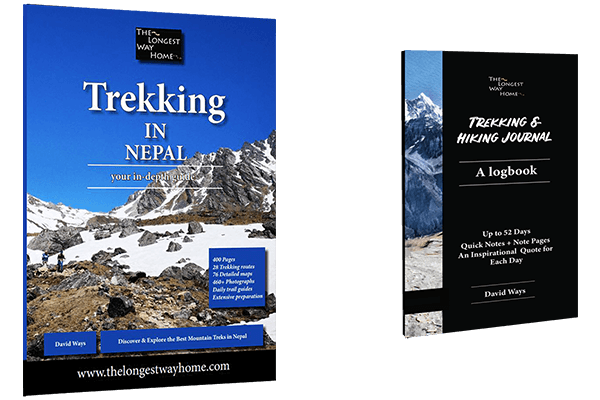
Get the Trekking in Nepal guidebook here!
Get the paperback Trekking & Hiking Journal here!
Or

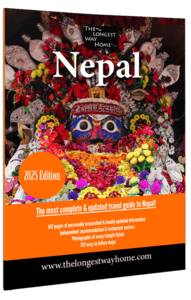
Why would they spend all that money and then create something that is not practical?
No idea. Someone thought it was a good idea. In some ways it is, the issue is TAAN/TIMS and the Manaslu area. But for Annapurna Treks it does offer trekkers an option.
So, it’s only useful if you want to trek the Annapurna Circuit without a guide?
It’s useful for all the Annapurna treks for both solo and treks with guides. It puts you as a trekker in charge of getting your permits if you want to go that route. Trekking agencies also use the same portal.
Good to see you are on top of this. Also, good to know we can just skip it ha ha
It’s progress. Slow progress.
I think we’ll just go with a guide to avoid all the hassle.
For the Manaslu trek, yes, just go to with a guide. It is the only way to go anyway!